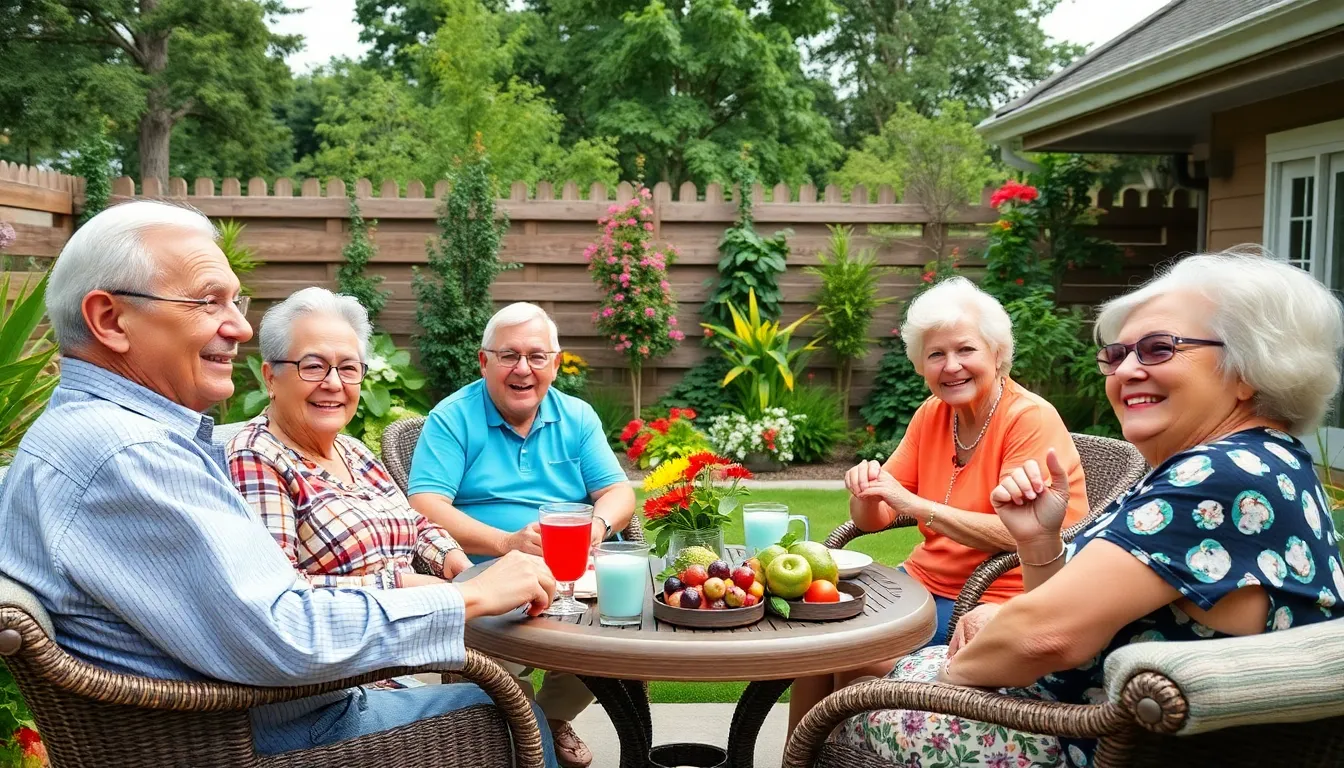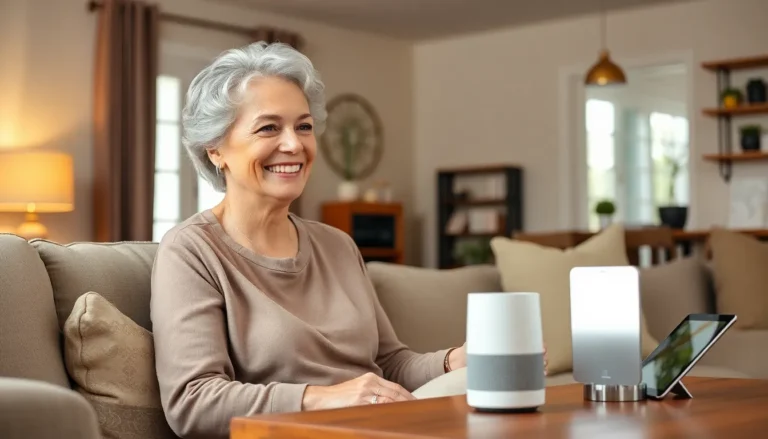Table of Contents
ToggleRetirement opens up a world of possibilities, and choosing the right living situation can significantly enhance this new chapter. Many retirees are trading in the hustle and bustle of city life for peaceful, community-oriented environments that cater to their needs and preferences. From active adult communities to cozy cottages, the options are endless.
Retired home living isn’t just about finding a place to stay; it’s about embracing a lifestyle that promotes well-being, social engagement, and personal fulfillment. With amenities designed for comfort and convenience, retirees can focus on enjoying their golden years while forging new friendships and pursuing hobbies. Discovering the ideal retirement home can transform these years into some of the most rewarding of one’s life.
Overview of Retired Home Living
Retired home living emphasizes comfort, convenience, and community. Many retirees prioritize tranquil environments that promote relaxation and well-being. These homes often cater to specific lifestyles, offering amenities such as recreational activities, fitness centers, and social events.
Types of Retired Homes
- Independent Living Communities
Independent living communities support active lifestyles with private residences and communal activities.
- Assisted Living Facilities
Assisted living facilities provide personal care services while maintaining a level of independence for residents.
- Memory Care Units
Memory care units offer specialized support for individuals with memory disorders, ensuring a secure and nurturing environment.
- Continuing Care Retirement Communities (CCRCs)
CCRCs provide a full spectrum of care, enabling residents to transition between different levels of care as needed.
Benefits of Retired Home Living
- Social Engagement
Retired home living fosters social interaction through scheduled events and shared spaces.
- Safety and Security
These homes often include security features such as monitored access and emergency response services.
- Maintenance-Free Living
Residents typically enjoy maintenance-free living, reducing the burden of home upkeep.
- Access to Services
Many communities provide easy access to healthcare services, transportation, and shopping.
Considerations for Choosing a Retired Home
- Location
Choosing a location close to friends, family, and necessities enhances overall satisfaction.
- Cost
Evaluating affordability and understanding the structure of fees is crucial for long-term financial planning.
- Amenities
Reviewing available amenities helps ensure a fulfilling lifestyle that meets personal preferences.
- Community Atmosphere
Assessing the community culture and resident interactions can significantly impact happiness and engagement.
Retired home living creates opportunities for enjoyment and fulfillment, aligning choices with individual needs and preferences.
Benefits of Retired Home Living


Retired home living offers numerous advantages that significantly enhance the quality of life for retirees. These benefits contribute to an overall positive lifestyle, promoting well-being and engagement.
Enhanced Lifestyle
Enhanced lifestyle encompasses better access to amenities, recreational activities, and personalized services in retired homes. Residents benefit from facilities designed for comfort and convenience. For example, many communities provide fitness centers, swimming pools, and landscaped gardens, encouraging physical activity. On-site dining services offer nutritious meals tailored to dietary needs. Additionally, wellness programs frequently focus on mental and emotional health, fostering a holistic approach to wellness. Overall, retiring in such environments leads to a more fulfilling life, enriched with opportunities for personal growth.
Social Opportunities
Social opportunities thrive in retired home living, promoting interaction and community building among residents. Most communities host organized activities, such as game nights, classes, and outings, encouraging participation and connection. Group activities foster friendships, reducing feelings of isolation that retirees may experience. Events like holiday celebrations and interest-based clubs cater to diverse interests, allowing residents to share passions with others. Ultimately, the social landscape of retired homes supports meaningful relationships and creates a vibrant community atmosphere.
Types of Retired Home Living Options
Retired home living offers various options tailored to diverse lifestyles and needs. Each type of community provides unique benefits, catering to both active and supportive living preferences.
Active Adult Communities
Active adult communities serve retirees seeking an active lifestyle without the responsibilities of home maintenance. These neighborhoods often feature single-family homes or condos designed for residents aged 55 and older.
- Amenities include clubhouses, fitness centers, and swimming pools.
- Social opportunities consist of organized activities like fitness classes, group outings, and hobby clubs.
- Residents enjoy a vibrant atmosphere, fostering friendships and promoting a sense of community.
- Many communities prioritize security, offering gated entrances and on-site staff for added peace of mind.
Independent Living Facilities
Independent living facilities cater to seniors who prefer a maintenance-free lifestyle while retaining their independence.
- These facilities offer private apartments or suites with access to on-site dining, laundry, and cleaning services.
- Many options include recreational programs, wellness activities, and transportation services to help residents maintain an active lifestyle.
- Safety measures like emergency response systems and staff availability provide additional peace of mind.
- Independence remains a key focus, allowing residents to customize their daily routines while enjoying social interactions with peers.
Considerations When Choosing a Retired Home
Selecting the right retired home involves several key considerations that impact a retiree’s quality of life. Understanding these factors aids in making an informed decision.
Location and Accessibility
Location plays a crucial role in a retiree’s overall satisfaction with their living situation. Retirees often prefer areas that are close to family, friends, and essential services. Key considerations include:
- Proximity to Healthcare: Choosing a location near quality medical facilities ensures access to healthcare when necessary.
- Transport Options: Availability of public transportation enhances mobility, allowing retirees to maintain independence without relying solely on personal vehicles.
- Nearby Amenities: Access to grocery stores, shopping centers, and cultural sites enrich the living experience and reduce the need for long-distance travel.
Accessibility also matters for retirees with mobility concerns. They should consider homes designed with features like ramps, elevators, and walk-in showers that facilitate ease of movement.
Amenities and Services
Amenities and services vary significantly among retired homes and can greatly influence the living experience. Important aspects include:
- Recreational Facilities: Access to fitness centers, swimming pools, and walking trails supports physical well-being and encourages active lifestyles.
- Dining Options: Quality dining services, including meal plans and diverse menu choices, contribute to convenience and social interaction during meals.
- Social Activities: Organized events and clubs foster community engagement and allow residents to form meaningful connections with their peers.
- Personal Care Services: Availability of housekeeping, transportation services, and wellness programming ensures that residents receive support tailored to their individual needs.
By evaluating the location and the amenities offered, retirees can make a decision that enhances their living experience and aligns with their lifestyle preferences.
Financial Aspects of Retired Home Living
Financial considerations play a crucial role in selecting the right retired home. A comprehensive understanding of budgeting and available financial assistance ensures a comfortable living experience.
Budgeting for Retired Home Living
Budgeting for retired home living involves assessing various costs that influence a retiree’s financial situation. Important expenses include:
- Housing Costs: Monthly rent or purchase prices for independent living units, assisted living services, or CCRCs. Housing prices vary significantly based on location and community amenities.
- Utilities and Maintenance: Expenses related to heating, cooling, water, and maintenance services, which may be included in monthly fees or paid separately.
- Food and Dining: Costs for meals offered in retirement communities, which can vary depending on the dining plan chosen.
- Health Care: Anticipated medical expenses, including regular check-ups, medications, and potential long-term care needs.
- Recreational Activities: Fees for classes, events, and organized outings that enhance the social life of the community.
Retirees should calculate their monthly income, considering Social Security benefits, pensions, and retirement accounts, to create an effective budget. Staying flexible with spending can accommodate unforeseen expenses while ensuring a comfortable lifestyle.
Insurance and Financial Aid Options
Exploring insurance and financial aid options can help retirees manage costs effectively. Relevant options include:
- Long-Term Care Insurance: Policies that cover healthcare services not included in standard health insurance, offering financial support for assisted living or nursing care.
- Medicare and Medicaid: Federal programs providing various services and financial assistance for individuals with limited income and assets. Understanding eligibility and coverage is vital for maximizing benefits.
- Veterans’ Benefits: Programs designed to assist veterans with healthcare costs, home modifications, or living expenses. Many veterans may qualify for aid through the Department of Veterans Affairs.
- Supplemental Security Income (SSI): A needs-based program providing financial assistance to eligible low-income retirees, ensuring they can meet basic living expenses.
- Community Resources: Local organizations and non-profits may offer financial assistance, grants, or services to support seniors in managing costs associated with retired home living.
By evaluating these options, retirees can create a financial plan that supports their desired living situation while ensuring peace of mind throughout their retirement years.




